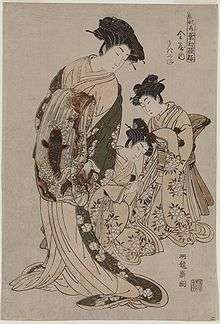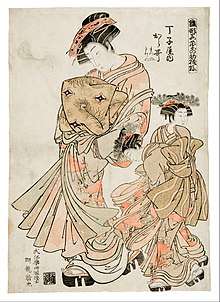Koryūsai
Isoda Koryūsai (礒田 湖龍斎, 1735–1790) was a Japanese ukiyo-e print designer and painter active from 1769 to 1790.

Life and career
Koryūsai was born in 1735 and worked as a samurai in the service of the Tsuchiya clan. He became a masterless rōnin after the death of the head of the clan and moved to Edo (modern Tokyo) where he settled near Ryōgoku Bridge in the Yagenbori area. He became a print designer there under the art name Haruhiro in 1769, at first making samurai-themed designs. The ukiyo-e print master Harunobu died in 1770, and about that time Koryūsai began making prints in a similar style of life in the pleasure districts.[1]
Koryūsai was a prolific designer of individual prints and print series,[1] most of which appeared between 1769 and 1881.[2]
In 1782 Koryūsai applied for and received the Buddhist honour hokkyō ("Bridge of the Law")[1] from the imperial court[3] and thereafter used the title as part of his signature. His output slowed from this time, though he continued to design prints until his death in 1790.[1]
Work
Koryūsai's known designs total 2500, or an average of four a week. According to art historian Allen Hockley, "Koryūsai may ... have been the most productive artist of the eighteenth century".[2]
The series Models for Fashion: New Designs as Fresh Young Leaves (Hinagata wakana no hatsumoyō, 1776–81) ran for 140 prints, the longest ukiyo-e print series of beauties known. He designed at least 350 hashira-e pillar prints, numerous kachō-e bird-and-flower prints, a great number of shunga erotic prints, and others.[1] 90 of his nikuhitsu-ga paintings are known, making him one of the most productive painters of the period.[2]

Legacy
Despite the Koryūsai's productivity and popularity—both in his time and amongst later collectors—his work has attracted little scholarship.[4] The first ukiyo-e histories written in the West in the 19th century elevated certain artists as examplars; Koryūsai work came to be seen as too indebted to Harunobu, who died in 1770, and inferior to Kiyonaga, whose peak period came in the 1880s.[3] An example is Woldemar von Seidlitz's Geschichte des japanischen Farbenholzschnittes ("History of Japanese colour prints", 1897), the most popular of the early ukiyo-e histories, which paints Koryūsai as a successor to Harunobu and a rival of Kiyonaga's in the 1770s who slipped into mediocrity and imitation of his rival by the end of the decade.[5] Interest lay mainly in the details of Koryūsai's life—a samurai who received court honours was unusual in the proletarian world of ukiyo-e.[3]
References
- Marks 2012, p. 60.
- Hockley 2003, p. 3.
- Hockley 2003, p. 4.
- Hockley 2003, pp. 3–4.
- Hockley 2003, p. 11.
Works cited
- Hockley, Allen (2003). The Prints of Isoda Koryūsai: Floating World Culture and Its Consumers in Eighteenth-century Japan. University of Washington Press. ISBN 978-0-295-98301-1.CS1 maint: ref=harv (link)
- Marks, Andreas (2012). Japanese Woodblock Prints: Artists, Publishers and Masterworks: 1680–1900. Tuttle Publishing. ISBN 978-1-4629-0599-7.CS1 maint: ref=harv (link)
External links

- Works
- Kimbell Art Foundation
- Artelino
- Museum of Fine Arts Boston
- Fine Arts Museum San Francisco